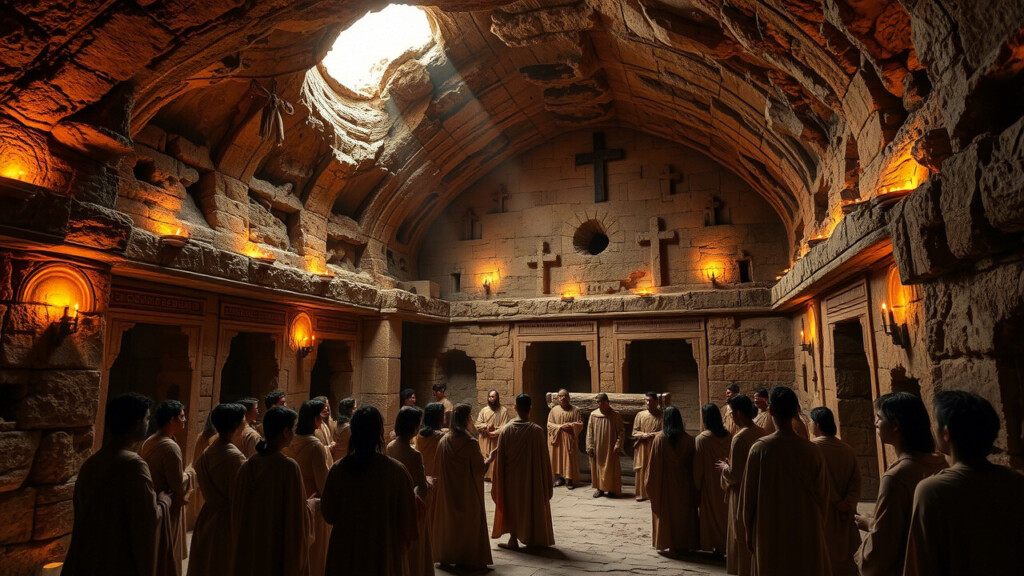Have you ever wondered, amidst the fiery gladiatorial arenas and magnificent temples of ancient Rome, how a tiny “seed” of faith could take root, spread, and eventually shake an entire empire? The answer doesn’t lie on the paved roads, but deep underground – where dark catacombs witnessed silent prayers, more powerful than the roar of lions. This is the story of the Roman Underground Church.

A Vortex of Persecution and Extraordinary Resilience
In the eyes of the Roman authorities, the early Christians were not only heretics but also a potential threat to the imperial order. They refused to worship the emperor as a god, did not participate in state religious rites, and preached a faith without borders. This era of Early Christian Persecution left a deep mark on history.
Violence against Christians came not only from official edicts but also from the wary social psychology. When the Great Fire of Rome in 64 AD burned down nearly two-thirds of the city, Emperor Nero – needing a scapegoat – blamed the Christians. From there, the wave of persecution escalated. The arenas became the stage for horrific executions: believers were thrown to wild beasts, crucified, and burned alive during royal banquets.
Yet, even in the face of terror, their faith did not weaken but spread further. As the Church Father Tertullian asserted: “The blood of the martyrs is the seed of the Church.” The deaths of these Christian Martyrs, did not just end a life, but ignited a spreading power.
Catacombs – The Underground Sanctuary
Under harsh persecution, Christian communities sought refuge in the catacomb systems to maintain their religious life. These were not only burial places but also centers of religious activity, where they could worship undetected. The Catacomb Sanctuary became a symbol of resilience.
Stepping into the narrow corridors of the catacombs, you will see walls covered with simple but meaningful drawings. The fish (Ichthys), a secret symbol referring to Jesus. The dove, a sign of the Holy Spirit. The olive branch, a symbol of peace. The anchor, embodying hope. This was how believers communicated with each other when any word could become evidence of guilt.
Unlike the magnificent Roman temples, this Catacomb Sanctuary was a cathedral carved in stone, under the flickering light of oil lamps. That space, though dark, was radiant with faith.
The Eucharist – A “Last Supper” in the Darkness
In small chambers hidden deep underground, believers gathered to celebrate the Eucharist, reenacting the last supper of Jesus with his disciples. There were no grand ceremonies, no echoing bells, only pieces of bread, a little wine, and silent sharing.
But it was in that simplicity that they found strength, a testiment to Faith Strength Adversity. Each time they broke bread and raised the cup of wine, they not only remembered the Lord but also affirmed their solidarity in the face of danger. The “Last Supper” in the underground was not only a religious ritual but also a common vow, where faith was not only maintained but also continued to spread.
Faith Over Death: The Martyrs
Not everyone was lucky enough to survive the persecutions. But what is astonishing is that instead of fear, many faced death with serenity. The images of the Christian Martyrs became a great source of inspiration.
Legend tells of Saint Agnes, a Roman maiden executed for refusing to renounce her faith. When she was led to the arena, her hair suddenly grew to cover her body, like a miracle protecting her chastity. Or Saint Lawrence, before being roasted on a gridiron, still joked with his executioners: “I’m done on this side, turn me over!”
Stories like these not only nurtured faith within the Roman Underground Church community but also perplexed the Roman authorities. How could a faith that could make people sacrifice their lives be extinguished?
Eternal Legacy: From Catacombs to the Throne
After nearly three centuries of persecution, a historical turning point arrived. In 313, Emperor Constantine issued the Edict of Milan, legalizing Christianity. The believers who once had to hide in the dark now came out into the light, building magnificent cathedrals on the very lands that had witnessed their martyrdom.
But the Roman Underground Church did not only leave a material legacy. It is living proof of the power of faith, perseverance, and the ability to change the world from the seemingly smallest things. From the cramped catacombs, from the whispered prayers in the darkness, a religion rose to influence billions of people afterward. The era of Early Christian Persecution forged a steadfast faith.
The story of the underground church is not simply history, but also a reminder that, even in the darkest moments, people can find the light. It showcases how Faith Strength Adversity can prevail.
Other Perspectives to Consider
Although Christianity was severely persecuted, were all Romans hostile to them? Some historians argue that the persecution policy was not always comprehensive, but depended on each emperor and the political situation.
Furthermore, Christianity was not only a victim. When it became the state religion, it itself launched persecutions against other religions. Is there a historical cycle, where the oppressed one day become the oppressor?
The Roman Underground Church is not only a period in the history of Christianity, but also a story of the inner strength of people in the face of adversity. It raises a bigger question: what truly makes a strong faith? Is it precisely the tough challenges that are the environment that helps faith become resilient?
And more importantly, how can the lessons from that period of Early Christian Persecution be applied to the world today, when faith – whether religious or ideological – still has to struggle to survive? Faith Strength Adversity remains a valuable lesson.
